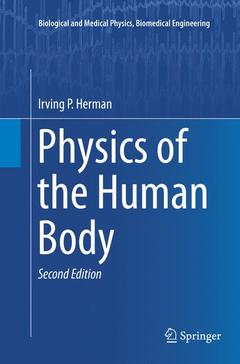Description
Physics of the Human Body (2nd Ed., 2nd ed. 2016)
Biological and Medical Physics, Biomedical Engineering Series
Author: Herman Irving P.
Language: English
Subject for Physics of the Human Body:
Keywords
Acoustics of Sound Waves in Speaking and Hearing; Biophysics of the Skelleton; Electrical Properties of the Body; Energetics of Body Metabolism; Engineering Aspects of Human Physiology; Fluid Flow in Cardiovascular Systems; Mechanical Properties of the Body; Physics for Med Students; Physics of Sports; Vision and Optics of the Eye
Publication date: 03-2018
Support: Print on demand
Publication date: 01-2016
953 p. · 15.5x23.5 cm · Hardback
Description
/li>Contents
/li>Biography
/li>Comment
/li>
Irving P. Herman is Professor of Applied Physics in the Department of Applied Physics and Applied Mathematics at Columbia University in New York, NY. He received B.S. and Ph.D degrees in physics from MIT, where he was a Fannie and John Hertz Predoctoral Research Fellow. He then joined the Lawrence Livermore National Laboratory, which he left in 1986 to join Columbia University. His main research areas have evolved from using lasers for separating deuterium and tritium isotopes, to following and inducing thin-film reactions, and, more recently, to analyzing nanomaterials, and also investigates the guided assembly of nanomaterials. He is a fellow of the American Physical Society and the Optical Society of America, held the Lady Davis Fellowship Visiting Professorship at Hebrew University, and was the Seidman Family Series Lecturer at the Technion. He was chair of his department for six years and director of the National Science Foundation MRSEC Center for Nanostructured Materials at Columbia for 12 years. He has also authored the monograph Optical Diagnostics for Thin Film Processing and over 150 papers in peer reviewed journals, and has three patents.
These books may interest you

Human Physiology 83.98 €


